|
|
|
|
The dance organs built by Hooghuys certainly belong to the crème
the la crème of all organs ever manufactured. The instruments
have a very clear sound with contrasting registers, which are
very suitable for 'light music' like mazurkas, schottisches,
polkas, …
Unfortunately, only few Hooghuys dance organs have remained unaltered:
some (like LH630 in Thursford) were rebuilt to 'a semi-fairground
organ', while others were enlarged (e.g. LH605 "Condor"). Anyway,
Hooghuys never built book organs with more than 100 keys, so
instruments with such a number of keys have certainly been modified.
Some instruments originally had an automatic guitar or mandolin,
but judging from the small amount of factory books that actually
use these registers, this probably wasn't a great success. Therefore,
it is not surprising that in many organs these registers have
been removed, because they quickly got out of tune ánd because
their sound was generally drowned by that of other registers.
The organ in the Museum van Speelklok tot Pierement in Utrecht
(NL) still has the mandolin register, but the mechanism is not
attached. The only organ that does have a working mandolin, is
LH595 ("Big Bertha") of Ted Bowman from Clophill (GB); the mechanism
of the mandolin comes from LH507, a 93-key dance organ that Romain
Charles Hooghuys bought in the early ‘60s. Romain disassembled
the organ for spare parts.
It might be interesting to know that the scale of most Hooghuys
dance organs is always the same up to the grosse
caisse (bass drum).
Furthermore, some organs had a scale that matches the so-called
Gavioli G4-scale (e.g. the above-mentioned LH507).
The façades of the organs vary a lot, but they are usually easy
to recognize, because they are hardly similar to those of other
organ manufacturers. Typically Hooghuys are the small ‘chapels'
which house the vox humana (a.o. on the "Condor" and the organ
in Utrecht). Some instruments had a nearly identical façade (e.g.
LH600 and LH605, as well as LH640 and LH645); differences are
usually very small, apart from disposition divergences.
|
|
|
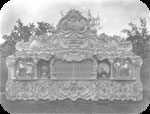 |
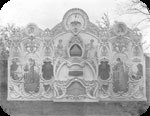 |
|
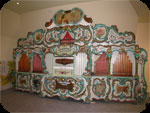 |
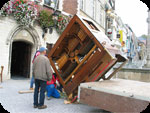 |
Two
factory photos of dance organs. Simply eye-catching is the
façade of the right organ; this organ was one of the instruments
with a Gavioli G4-scale. |
|
A
well-known dance organ: LH553, located here in the room of
the Tourist Service of Geraardsbergen.
The organ is one of the 'lucky few' that has hardly been altered.
It is one of the first organs with a mechanism that Hooghuys
would later use in all his dance organs.
The organ became quite famous after A.Becquart sold it to the
well-known English collector Barlow, who named it "Prince Carnival".
Afterwards, Arthur Prinsen brought the instrument back to Belgium
and in 1986, he sold it to the city of Geraardsbergen which
placed in the cafeteria of camping ground "De Gavers". That
location was far from ideal, though, so in 2002 it was decided
to move the organ to the Tourist Service. There, Marc Hooghuys
repaired the instrument so it played well again.
However, in 2004 the organ was moved again, this time to the
Music academy in Geraardsbergen. Unfortunately, this location
is very bad and the organ doesn't play. But there's hope, since
a Circle of Hooghuys Friends devotes its time and energy towards
finding a better place for the organ.
|
| |
|
|
 |
 |
 |
 |
 |
|
|
|
| |
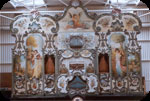 |
|
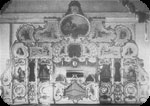 |
 |
|
 |
|
| |
70-key
LH595 "Big Bertha" owned by Ted Bowman. Apart from having
a working mandolin, the organ also has an extensive repertoire
with original arrangements by Louis and Romain Charles Hooghuys;
there are also splendid arrangements by August Schollaert. |
|
This
organ – the 85-key LH600 – is very similar to LH605
"Condor". The organ was sold to England, where it is owned
by the son of Melville Watts.
As you can see on the right picture, the façade has been seriously
cut down; moreover, internal changes have been made too: originally,
the organ had a mandolin ánd a guitar but both have been removed.
Furthermore, the organ has a wind chest and a key frame from
a Mortier organ – a modification carried out by Pierre Verbeeck.
|
|
The well-known
100-key LH605 "Condor", now to be seen in the Boudewijnpark
in Brugge. The organ became famous thanks to an LP on the
Decca-label.
The organ was originally built as a 97-key instrument but Romain
Charles enlarged it to 100 keys, a.o. by installing piccolo's
using separate keys.
Unfortunately, the organ is not in optima
forma anymore …
|
|
|
|
|
| |
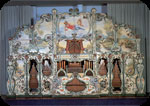 |
 |
|
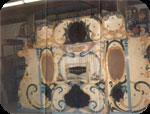 |
|
 |
|
| |
The 90-key LH615 in the Nationaal Museum van Speelklok
tot Pierement in Utrecht (NL). This organ still has a mandolin
(which is located above the name plate) but the mechanism
is not attached.
The façade is now completed with the top piece on the right
picture: this part was obviously forgotten when the organ
was bought. Marc Hooghuys made sure that it returned where
it belongs.
Interesting about this organ is that the lovely Jugendstil-façade
was only delivered years after the organ itself: the instrument
was probably already finished before the outbreak of WWI
but only got its façade after the end of the hostilities.
|
|
71-key
LH620, on this photo in possession of Ron Bennett; the organ
is now owned by Bill Nunn (USA).
The organ has more or less the same scale as Ted Bowman's LH595.
The instrument has been completely overhauled by Bill Nunn
and is now named "Sunflower".
Charles Hooghuys once owned this particular organ; he placed
it in his café.
|
|
101-key
LH630 in the Thursford Collection of the late George Cushing.
The organ was sold by Albert Becquart to George Cushing in
the early ‘60s, together with LH640 and LH645. Before that,
the organ had already been modified and enlarged to adapt it
for use on the fairgrounds.
|
|
| |
|
|
|
|
|
|
|
|
| |
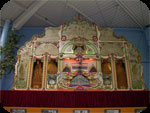 |
|
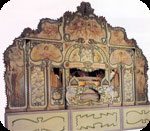 |
|
 |
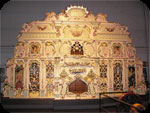 |
|
|
83-key
LH640 on its current location, on an elevated platform in
the Auto & Technik Museum in Sinsheim (D).
For a long time, this organ was part of the collection of the
Turner family in England; it found its way to its current spot
via Retonio in Switzerland.
|
|
101-key
LH645, which can be found in Thursford like LH630.
This organ has a façade that is identical to the one of LH640;
its scale used to be the same too, but it was altered so books
could be exchanged with LH630.
At this moment, a team led by Bob Ince (with the cooperation
of Judith Howard) is bringing back the organ to its original
specifications as much as possible.
|
|
84-key
LH650 in the Sanfilippo-collection in the USA. This was one
of the last organs manufactured under Louis Hooghuys; after
Louis' decease, it was assembled by Charles (hence the initials
"Ch." on the name plate; but the organ does have serial no.LH650).
Underlying layers of paint have shown that the façade was
manufactured by Mortier, but it is unclear whether Charles
or later owners have 'united' this façade with the organ.
For a long time, the organ was a popular crowd puller in Café
Toerist in Loppem (B); from there it was sold to the USA via
J.Verbeeck.
|
|
|
|
